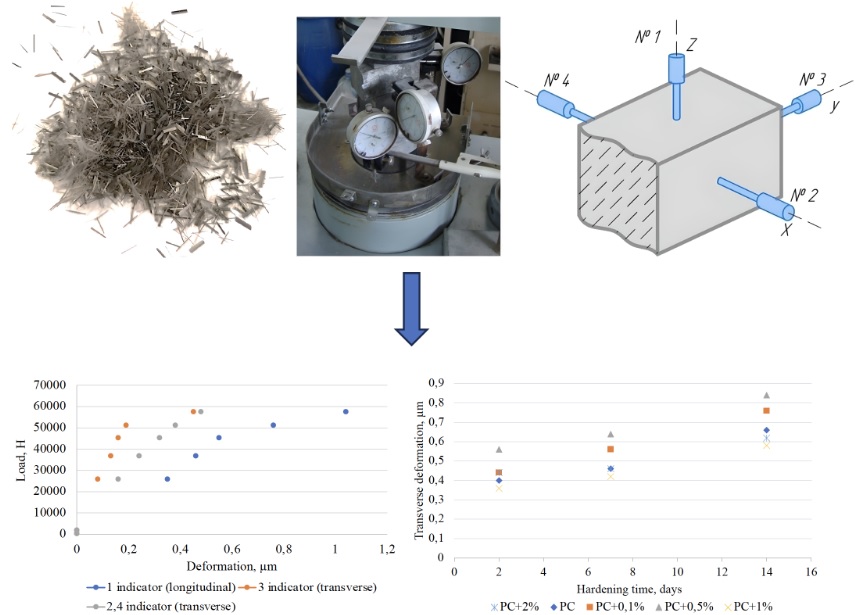Identifying the influence of basalt fiber reinforcement on the deformation and strength characteristics of cement stone
DOI:
https://doi.org/10.15587/1729-4061.2023.288551Keywords:
oil well cement, cement composite materials, basalt fiber, strength, deformation characteristicsAbstract
The object of the research is the quality of cementing oil and gas wells with increasing the strength and deformation capacity of cement stone using basalt fibers.
Cement slurry used in cementing oil and gas wells faces the problem of failure under the influence of hydraulic fracturing and perforation procedures. This failure leads to the formation of cracks and may require remedial cementing, which increases operating costs and complicates the process of oil and gas production. Moreover, this problem can lead to premature well water breakthrough and cause serious damage such as oil and gas shows and blowouts, which poses a threat to the environment and safety. To solve the problem of the destruction of cement stone under external influences, the study proposed the approach of reinforcing with basalt fiber.
During the study, a cementing material based on Portland cement, reinforced with various concentrations of basalt fibers (0.1 %, 0.5 %, 1 % and 2 %), was developed and tested. Cement strength tests at 2, 7, and 14 days, along with deformation monitoring under load, were performed.
The addition of basalt fibers to cement stone significantly improved its strength characteristics. The most successful results were achieved with the addition of 0.5 % basalt fibers, resulting in an 11 % increase in compressive and flexural strength. Basalt fibers complement the structure of cement stone, increasing its ability to deform.
One of the key features of the obtained results is the possibility of improving the strength of the cement stone without losing its fluidity as a cement slurry.
The results obtained are applicable in the development and production of cement materials based on basalt fibers. This will improve the quality of well cementing and reduce the risks of complications
References
- Zhu, H. Y., Deng, J. G., Zhao, J., Zhao, H., Liu, H. L., Wang, T. (2014). Cementing failure of the casing-cement-rock interfaces during hydraulic fracturing. Computers and Concrete, 14 (1), 91–107. doi: https://doi.org/10.12989/cac.2014.14.1.091
- Fedorov, B., Ratov, B., Sharauova, A. (2017). Development of the model of petroleum well boreability with PDC bore bits for Uzen oilfield (the Republic of Kazakhstan). Eastern-European Journal of Enterprise Technologies, 3 (1 (87)), 16–22. doi: https://doi.org/10.15587/1729-4061.2017.99032
- Yan, Y., Guan, Z., Yan, W., Wang, H. (2020). Analysis Method of Cement Sheath Damage Zone After Perforation. SPE/IATMI Asia Pacific Oil & Gas Conference and Exhibition. doi: https://doi.org/10.2118/196556-ms
- Purnell, P., Short, N. R., Page, C. L., Majumdar, A. J. (2000). Microstructural observations in new matrix glass fibre reinforced cement. Cement and Concrete Research, 30 (11), 1747–1753. doi: https://doi.org/10.1016/s0008-8846(00)00407-5
- Bheel, N. (2021). Basalt fibre-reinforced concrete: review of fresh and mechanical properties. Journal of Building Pathology and Rehabilitation, 6 (1). doi: https://doi.org/10.1007/s41024-021-00107-4
- Paiva, L. C. M., Ferreira, I. M., Martinelli, A. E., Freitas, J. C. de O., Bezerra, U. T. (2019). Milled basalt fiber reinforced Portland slurries for oil well applications. Journal of Petroleum Science and Engineering, 175, 184–189. doi: https://doi.org/10.1016/j.petrol.2018.11.068
- Zheng, Y., Zhang, Y., Zhuo, J., Zhang, Y., Wan, C. (2022). A review of the mechanical properties and durability of basalt fiber-reinforced concrete. Construction and Building Materials, 359, 129360. doi: https://doi.org/10.1016/j.conbuildmat.2022.129360
- Wang, S., Chen, F., Xue, Q., Zhang, P. (2020). Splitting Tensile Strength of Cement Soil Reinforced with Basalt Fibers. Materials, 13 (14), 3110. doi: https://doi.org/10.3390/ma13143110
- Afroz, M., Patnaikuni, I., Venkatesan, S. (2017). Chemical durability and performance of modified basalt fiber in concrete medium. Construction and Building Materials, 154, 191–203. doi: https://doi.org/10.1016/j.conbuildmat.2017.07.153
- Ayub, T., Shafiq, N., Nuruddin, M. F. (2014). Mechanical Properties of High-performance Concrete Reinforced with Basalt Fibers. Procedia Engineering, 77, 131–139. doi: https://doi.org/10.1016/j.proeng.2014.07.029
- Zhang, H., Wang, B., Xie, A., Qi, Y. (2017). Experimental study on dynamic mechanical properties and constitutive model of basalt fiber reinforced concrete. Construction and Building Materials, 152, 154–167. doi: https://doi.org/10.1016/j.conbuildmat.2017.06.177
- Zhou, H., Jia, B., Huang, H., Mou, Y. (2020). Experimental Study on Basic Mechanical Properties of Basalt Fiber Reinforced Concrete. Materials, 13 (6), 1362. doi: https://doi.org/10.3390/ma13061362
- Yang, L., Xie, H., Fang, S., Huang, C., Yang, A., Chao, Y. J. (2021). Experimental study on mechanical properties and damage mechanism of basalt fiber reinforced concrete under uniaxial compression. Structures, 31, 330–340. doi: https://doi.org/10.1016/j.istruc.2021.01.071
- Xie, L., Sun, X., Yu, Z., Zhang, J., Li, G., Diao, M. (2023). Experimental Study and Mechanism Analysis of the Shear Dynamic Performance of Basalt Fiber–Reinforced Concrete. Journal of Materials in Civil Engineering, 35 (1). doi: https://doi.org/10.1061/(asce)mt.1943-5533.0004549
- Zhang, H., Ji, S., Wang, L., Jin, C., Liu, X., Li, X. (2022). Study on dynamic splitting tensile damage characteristics of basalt fiber reinforced concrete based on AE and DSCM. Journal of Building Engineering, 57, 104905. doi: https://doi.org/10.1016/j.jobe.2022.104905
- Zhou, Y., Zou, S., Wen, J., Zhang, Y. (2023). Study on the damage behavior and energy dissipation characteristics of basalt fiber concrete using SHPB device. Construction and Building Materials, 368, 130413. doi: https://doi.org/10.1016/j.conbuildmat.2023.130413
- Kumbhar, P. V. (2014). An overview: basalt rock fibers-new construction material. Acta Engineering International, 2 (1), 11–18. Available at: https://www.researchgate.net/publication/302987042_An_overview_basalt_rock_fibres-new_construction_material
- Agzamov, F. A., Belousov, A. O. (2018). Substantiation of the methodology for assessing dangerous stresses in the body of cement stone during technological operations in a well. Oil Province, 4, 225–239.
- Gao, S. L., Mäder, E., Plonka, R. (2007). Nanostructured coatings of glass fibers: Improvement of alkali resistance and mechanical properties. Acta Materialia, 55 (3), 1043–1052. doi: https://doi.org/10.1016/j.actamat.2006.09.020
- Barhum, R., Mechtcherine, V. (2012). Effect of short, dispersed glass and carbon fibres on the behaviour of textile-reinforced concrete under tensile loading. Engineering Fracture Mechanics, 92, 56–71. doi: https://doi.org/10.1016/j.engfracmech.2012.06.001

Downloads
Published
How to Cite
Issue
Section
License
Copyright (c) 2023 Arman Kabdushev, Dinara Delikesheva, Darkhan Korgasbekov, Bauyrzhan Manapbayev, Marzhan Kalmakhanova

This work is licensed under a Creative Commons Attribution 4.0 International License.
The consolidation and conditions for the transfer of copyright (identification of authorship) is carried out in the License Agreement. In particular, the authors reserve the right to the authorship of their manuscript and transfer the first publication of this work to the journal under the terms of the Creative Commons CC BY license. At the same time, they have the right to conclude on their own additional agreements concerning the non-exclusive distribution of the work in the form in which it was published by this journal, but provided that the link to the first publication of the article in this journal is preserved.
A license agreement is a document in which the author warrants that he/she owns all copyright for the work (manuscript, article, etc.).
The authors, signing the License Agreement with TECHNOLOGY CENTER PC, have all rights to the further use of their work, provided that they link to our edition in which the work was published.
According to the terms of the License Agreement, the Publisher TECHNOLOGY CENTER PC does not take away your copyrights and receives permission from the authors to use and dissemination of the publication through the world's scientific resources (own electronic resources, scientometric databases, repositories, libraries, etc.).
In the absence of a signed License Agreement or in the absence of this agreement of identifiers allowing to identify the identity of the author, the editors have no right to work with the manuscript.
It is important to remember that there is another type of agreement between authors and publishers – when copyright is transferred from the authors to the publisher. In this case, the authors lose ownership of their work and may not use it in any way.








